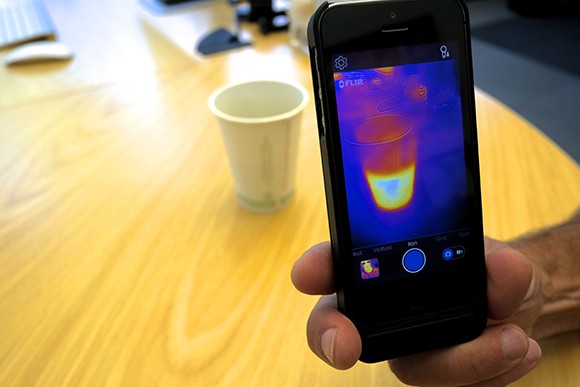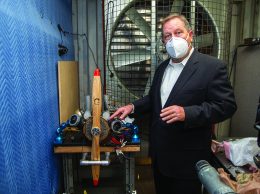Competition heats up in infrared market as Flir, Seek Thermal release smartphone products
IN THIS ARTICLE
- South Coast Topic
- Stephen Nellis Author
By Stephen Nellis Friday, August 22nd, 2014

Flir General Manager Bill Terre shows the company’s new infrared phone app recording a cup of coffee. (Stephen Nellis / Business Times photo)
This holiday season, two South Coast firms will compete to sell what could be the hottest gadget gift of the year: affordable thermal cameras for smartphones.
Goleta-based Seek Thermal, the company founded by longtime infrared entrepreneurs Bill Parrish and Tim Fitzgibbons that has raised $30 million, said Aug. 19 that it will offer a camera that plugs into smartphones to provide the same kind of thermal imaging previously used by firefighters and soldiers.
Seek Thermal’s camera will face off against the Flir One, a product conceived and designed in Goleta that wraps around a phone like a case. Flir announced the $349 camera in July, and it was slated to hit Apple stores as the Business Times went to press.
Thermal cameras are different from what most consumers think of as infrared imagery. The black-and-green pictures seen in military footage is actually an amplification of a small amount of existing visible light. Thermal cameras, by contrast, solely detect temperature differences and can see in complete darkness. They produce the brightly colored images popularized in the 1987 film “Predator.”
The high prices of thermal cameras have kept them confined to military, public safety and industrial uses. Civilian devices are available but usually cost thousands of dollars, showing up in products such as BMW’s high-end cars.
Both Seek Thermal and Flir have taken advantage of advancing technology to produce small, easily powered devices that can be sold for a few hundred dollars rather than thousands.
Neither company knows quite how the masses will use thermal imaging once it hits the market, and both plan to adapt quickly with apps and products to meet consumer demand as it emerges. The cameras could end up a in a range of devices, spurring a first-ever proliferation of thermal imaging that could fuel the South Coast’s economy.
Flir Systems
Oregon-based Flir Systems has about 400 employees in Goleta, and the new Flir One was born on the South Coast, said General Manager Bill Terre.
When thermal cameras were first invented, they cost about $100,000 and needed to be cooled to more than 300 degrees below zero because ambient room temperatures caused too much electronic noise. By the 1980s, uncooled cameras came along, and it is the several decades of refinement to those devices that ultimately led to the smartphone-ready products seen today, Terre said.
Flir’s entire camera is 5.5 millimeters across and is made to fit a standard socket used in smartphones so that designers can easily integrate it into other products. In addition to selling its own phone accessory, Flir is seeking out other companies who might want to use its cameras in their products.
“The size of that module wasn’t an accident. We envision that it eventually will end up resident in the handset. That size is what we imagine is the maximum form factor for a camera,” Terre told the Business Times. “We have been for some time in a wide-ranging pursuit of [original equipment manufacturers] who could take advantage of a camera this size.”
Flir has three apps available for its camera at the moment, but it is also releasing a software development kit to coders to make their own apps. Terre said demand for the kits has been strong.
“The killer app for this technology probably hasn’t been invented yet, but with this many people looking at it, I’m confident it will be,” he said.
Part of what has driven down the cost of the Flir One is integrating more and more techniques from standard semiconductor manufacturing into the process of making detectors and lenses. (Standard optical glass reflects heat and can’t be used in lenses for thermal cameras. The lenses have to be made of special materials and are usually the second-highest cost driver in a system.)
“We turned to the silicon foundry and said, ‘Hey, putting the detector on top of the other stuff isn’t all that unlike what you’re doing,’ ” Terre said.
Seek Thermal
Parrish and Fitzgibbons founded what is now Seek Thermal in 2012 with plans to commercialize the technology advances made at Raytheon Vision Systems, coupled with the chip manufacturing prowess of Freescale Semiconductor, the large chipmaking firm spun out of Motorola.
The pair has been involved in some of the most prominent infrared sensor companies in Goleta over several decades, including Indigo Systems, which was sold to Flir in 2004 for $185 million. There was a legal battle between the pair and Flir as they worked to start their new business. Parrish and Fitzgibbons were eventually awarded a $39 million settlement against Flir.
With legal issues in the rear-view mirror, the open market is ahead. Seek Thermal says its camera is smaller and plugs into the bottom of a phone. It also says its resolution is 32,000 pixels, more than six times higher than the 4,800 pixels in the Flir camera. Seek Thermal intends to sell its products for about $100 less than Flir.
Robert Acker, CEO and president of Seek Thermal, said smartphones have unlocked the huge potential of thermal sensors.
“If you can take a picture with an iPhone or Android phone, you can take a picture with our product, and you can carry it with you in the same way,” Acker said. “I think it will allow us to become part of daily life much faster.”
The advances made at Raytheon and Freescale are letting Seek Thermal pack more camera chips on a single wafer, driving down the costs. The company has also perfected a new take on lens technology that is slightly different from Flir’s approach.
Acker said Seek Thermal will work with outside companies to sell its camera internals for use in other products.
Acker said the most exciting aspect of the new product is inventive uses. Thermal cameras will show a “heat footprint” of where a warm object has been sitting for several minutes afterward. One early tester used Seek Thermal’s camera to see whether his dog had been illicitly sitting on the couch while his owner was away.
“What if you could look at a griddle and tell that the pancakes aren’t going to cook on one side but are going to burn on the other side? What if you could look at your grill’s propane tank and tell whether it’s only 10 percent full?” Acker said. “Nobody’s played around with these before, so it’s going to be really fun to come along for the ride.”











